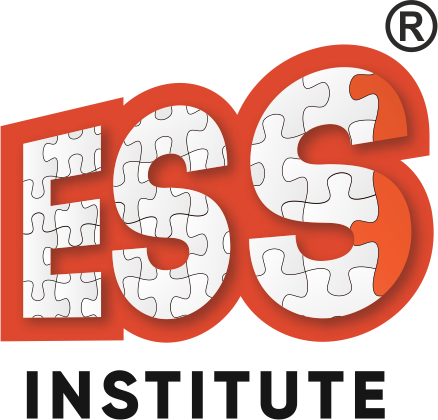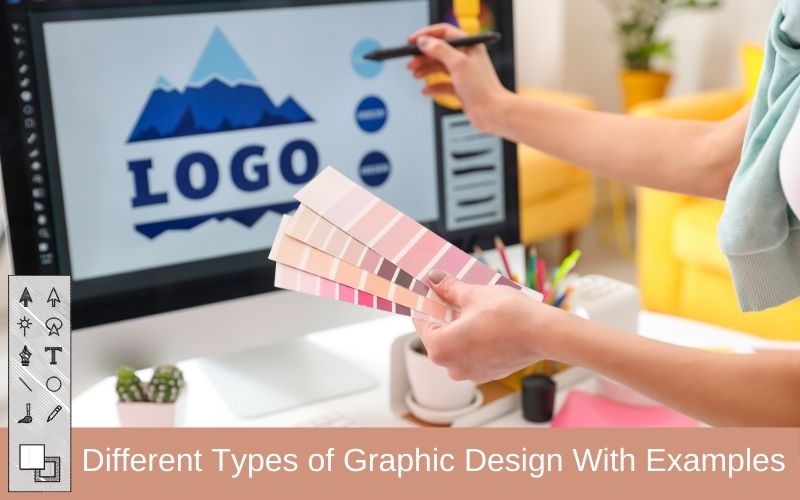Graphic design is a means of communicating with symbols rather than just creating pieces of art to change people’s perceptions and interactions with the environment. From symbols that could be globally identified as representing companies and products, to computer screens that are used daily which have icons, it has become a part of our daily lives today. However, this field is huge and complex because it has various specializations and applications in it. Knowledge of different types of graphic design can help you understand their diversity and find your niche or direction based on your interests and career ambitions.
In the below article, trainer from a graphic design institute in Delhi explains different types of graphic design with their particular skill sets, tool sets and creative processes.
Different Types of Graphic Design
1. Visual Identity Graphic Design
Visual identity graphic design deals with creating the visible elements that represent a brand, such as logos and typographies. All these work together in conveying the brand personality, values and emotion of a conviction, leading to an unforgettable brand image. A visual identity design is essential for any organisation which seeks to distinguish itself in its market segment or establish long-term relationships with its customers.
- Leagues: Starbucks’ mermaid, Amazon’s smile, Twitter’s bird.
- Peal Outlines: McDonald’s red and yellow, Pepsi’s blue and red, Google’s multicolor palette.
- Type Foundry: Coca-Cola’s script font, IBM’s corporate font, Netflix’s Sans font.

Famous Examples:
- Nike’s Swoosh: Created by Carolyn Davidson in 1971, this symbol just represents motion and speed which are two main aims of every athlete.
- ESS’s Puzzles: ESS Logo with puzzle represents how completing a puzzle is like giving students great graphic design skills for their career
- Apple’s Logo: It was also designed by Rob Janoff in 1977 using a bitten apple which indicates wisdom also corresponding to simple creativity values.
Visual identity graphic design is more than just aesthetics; it’s about creating a visual language that communicates a brand’s essence. A well-designed visual identity can set a brand apart in today’s crowded marketplace and help build emotional connections between the brand and its consumers.
2. Marketing & Advertising Graphic Design
Marketing and advertising graphic design is focused on promoting products or services through visually compelling campaigns. This type of design includes a wide range of media, from traditional print ads to digital banners, social media graphics, and email marketing templates. The primary goal is to capture attention, convey the message effectively, and drive consumer action. In marketing also we have different types of creative graphic design
- Print Ads: Full-page magazine ads, posters for movie promotions, flyers for local events.
- Digital Ads: Banner ads on websites, sponsored posts on social media, video ads on YouTube.
- Social Media Graphics: Instagram stories, Pinterest pins, Facebook event covers.
Famous Examples:

- Coca-Cola’s “Share a Coke” Campaign: This campaign personalized Coca-Cola bottles with people’s names. This encouraged social sharing and creating a strong emotional connection with consumers.
- Old Spice’s “The Man Your Man Could Smell Like” Campaign: Known for its humorous and memorable commercials, this campaign revitalized the Old Spice brand and boosted sales significantly.
Marketing and advertising graphic design requires a deep understanding of both design principles and consumer psychology. Designers in this field must be adept at creating visuals that not only attract attention but also resonate with the target audience and inspire them to take action.
3. User Interface (UI) Graphic Design
User Interface (UI) graphic design focuses on visual aspects. It includes web pages, mobile applications and software programs. Plus, User Interface (UI) graphic design emphasizes attractive layouts, consistent design styles, ease of navigation and organization among others. This discipline involves developing graphics such as icons or buttons that help users interact with content in a computerized environment. Designers also create information architecture by designing menus or user flows that facilitate movement through different pieces of information onscreen.
Learn User Interface design from our online UI Design course hindi
- Website Layouts: E-commerce product pages, portfolio websites, landing pages for marketing campaigns.
- App Interfaces: Navigation menus for mobile apps, interactive elements like buttons and sliders, in-app notifications.
- Dashboard Designs: Analytical tools for businesses, financial dashboards for personal finance apps, content management systems for bloggers.

Famous Examples:
- Spotify’s User Interface: Known for its sleek design and user-friendly navigation, Spotify’s UI allows users to easily discover and enjoy music across various devices.
- Google’s Material Design: Introduced in 2014, Material Design is a design language that provides a unified experience across Google’s products. It uses grid-based layouts, responsive animations, and consistent padding to create a clean and intuitive interface.
UI graphic design is a critical component of any digital product, as it directly impacts the user’s experience and satisfaction. A well-designed UI can make complex information accessible and make the product successful.
4. Publication Graphic Design
Publication graphic design refers to the design of printed and digital publications, such as books, magazines, newspapers, and eBooks.
This sort of style concentrates on creating layouts, selecting typefaces, and organizing content in such a manner that it looks good and is easy to follow at the same time. With the prominence of digital media, publication designers should be skillful in designing for the web guaranteeing accessibility among various devices.
- Books: Hardcover and paperback book covers, interior layouts, illustrated editions.
- Magazines: Cover designs, editorial spreads, feature article layouts.
- Newspapers: Front-page design, section headers, infographics for news stories.
Famous Examples:
- The New Yorker’s Covers: The New Yorker is renowned for its iconic covers, which often feature satirical illustrations that comment on current events and social issues.
- National Geographic’s Magazine Layouts: Known for its stunning photography and in-depth journalism, National Geographic’s publication design effectively combines visuals and text to tell compelling stories.
Publication graphic design requires a keen eye for detail and a strong understanding of typography, layout, and color theory. Designers in this field must balance aesthetics with functionality, ensuring that the content is both engaging and easy to consume.
5. Packaging Graphic Design
When it comes to packaging graphic design it is all about creating product packaging visuals which can be seen in packages and labels. There are boxes, bags and wrappers. There are other aspects which are equally critical in branding such as labeling and product packaging. You must consider the design of packaging materials first before starting any other thing because people make up their minds from their first impressions. The right packaging design will promote brand values and influence consumer choices in your brand’s favour.
- Food Packaging: Cereal boxes, chocolate bar wrappers, juice cartons.
- Cosmetic Packaging: Perfume bottles, lipstick tubes, skincare product containers.
- Electronics Packaging: Smartphone boxes, gaming console packaging, earbud cases.
Famous Examples:
- Apple’s iPhone Packaging: Apple’s packaging is known for its minimalist design, with clean lines, high-quality materials, and a focus on unboxing experience. The packaging reflects the brand’s commitment to quality and innovation.
- Coca-Cola’s Contour Bottle: Designed in 1915, the contour bottle is one of the most recognizable packaging designs in the world. Its unique shape not only distinguishes it from other beverages but also reinforces the brand’s identity.
Packaging graphic design is a powerful tool for brands to differentiate themselves in a competitive market. It requires a combination of creativity, technical skills, and an understanding of consumer behavior.
6. Motion Graphic Design
Motion graphic design is a combination of designing with animation to produce interesting images that can move around. Such designs find application on different media platforms such as video productions, social media content advertising web designs among others. Motion graphics can include animated text, logos, illustrations, and even entire scenes that tell a story or convey a message.
- Animated Logos: Logos that animate during the introduction of a video, such as the 20th Century Fox logo in movie openings.
- Title Sequences: Opening credits for movies and TV shows that combine typography and motion to set the tone for the production.
- Social Media Animations: GIFs, animated stories, and short video clips designed for platforms like Instagram, TikTok, and Facebook.
Famous Examples:
- Pixar’s Animated Films: Pixar is known for its cutting-edge animation technology and compelling motion graphics that bring characters and stories to life.
- The opening sequence of “Game of Thrones”: This intricate and dynamic title sequence uses motion graphics to map out the world of Westeros, setting the tone for the epic series.
Motion graphic design is essential for creating dynamic content that captures attention and enhances storytelling. It combines traditional graphic design principles with animation techniques, making it a versatile and in-demand skill in the digital age.
7. Environmental Graphic Design
Environmental graphic design (EGD) involves the design of visual elements within physical spaces. EGD uses graphics that are often immersive, and that communicate information clearly rather than advertising messages by mixing graphic design with architecture and interior design thus creating environments that are both effective at conveying content relevant to visitors and attractive enough for people to spend time in them. EGD is used in a variety of settings, including museums, retail spaces, corporate offices, and public spaces.
- Wayfinding Systems: Signage systems in airports, hospitals, and large commercial buildings that help people navigate the space.
- Exhibit Design: Visual and interactive displays in museums, trade shows, and galleries that educate and engage visitors.
- Branded Environments: Corporate office spaces that use branded colors, logos, and graphics to create a cohesive and inspiring work environment.
Famous Examples:
- The London Underground Map: Designed by Harry Beck in 1931, this iconic map is not only a functional wayfinding tool but also a masterpiece of design, with its simplified, color-coded lines that make navigation easy.
- The 9/11 Memorial & Museum: The environmental graphic design of this space uses typography, materials, and lighting to create a somber and reflective atmosphere that honors the memory of those lost.
Environmental graphic design is a multidisciplinary field that requires collaboration between graphic designers, architects, and interior designers. It plays a crucial role in shaping how we experience and interact with physical spaces.
8. Art and Illustration for Graphic Design
Art and illustration for graphic design involves creating original artwork that can be used in a variety of media, from books and magazines to advertisements and products. Unlike other types of graphic design, which focus on layout and typography, this type of design is more focused on drawing, painting, and creating visual art. Illustrations can be hand-drawn or created digitally, and they often play a key role in storytelling and visual communication.
- Book Illustrations: Illustrated children’s books, graphic novels, and book covers that use original artwork to enhance the story.
- Product Illustrations: Custom illustrations for packaging, apparel, and merchandise that add a unique visual element to the product.
- Editorial Illustrations: Illustrations for magazines and newspapers that complement the articles and add visual interest.
Famous Examples:
- Quentin Blake’s Illustrations for Roald Dahl’s Books: Blake’s whimsical and expressive illustrations are synonymous with Dahl’s stories, adding a layer of charm and personality to the books.
- Shepard Fairey’s “Hope” Poster: This iconic illustration of Barack Obama became a symbol of the 2008 presidential campaign and is now a widely recognized piece of political art.
Art and illustration for graphic design offer endless creative possibilities. It allows designers to bring their artistic vision to life and create visuals that are both unique and impactful.
9. Web Design
Web design is the process of creating websites with an emphasis on websites’ general appearance, features, and functions. Graphic designing in this respect is the amalgamation of different constructs including; user interface (UI) designs, user experience (UX) designs, and content creation meant to give gorgeous easy-to-use websites. They range from the arrangement and choice of colors to fonts and pictures it contains.
- E-commerce Websites: Online stores with product pages, shopping carts, and checkout processes designed for easy navigation and a seamless shopping experience. Read our ecommerce website development tutorial to create yours on wordpress in easy steps.
- Portfolio Websites: Personal websites that showcase a designer’s work, including galleries, case studies, and contact information.
- Blog Websites: Content-focused websites that organize articles, images, and multimedia content in an engaging and easy-to-navigate layout.
Famous Examples:

Web design is a critical component of any online presence. It requires a deep understanding of both design principles and technical skills, as well as an ability to create websites that meet the needs of both the business and its users.
10. Corporate Graphic Design
Corporate graphic design focuses on creating visual materials that represent a company’s identity and brand. This includes designing business cards, letterheads, annual reports, presentations, and other corporate communications. The goal is to ensure consistency across all visual elements, reinforcing the company’s brand image and values.
- Business Cards: Custom-designed cards that reflect the company’s branding, including logo, color scheme, and typography.
- Letterheads: Branded letterheads for official company communications, including invoices, contracts, and internal memos.
- Annual Reports: Visually engaging reports that present a company’s financial and operational performance in a clear and professional manner.
Famous Examples:
- IBM’s Corporate Design Program: Led by designer Paul Rand in the 1950s, IBM’s corporate design program set the standard for corporate graphic design, with its emphasis on consistency, simplicity, and professionalism.
- Google’s Brand Guidelines: Google’s corporate design is known for its use of clean, simple lines, vibrant colors, and a user-focused approach, all of which are reflected in its corporate communications.
Corporate graphic design is essential for building a strong and cohesive brand image. It requires a thorough understanding of the company’s values and goals, as well as the ability to translate these into visual elements that resonate with both internal and external audiences.
There are endless possibilities for creativity and innovation in the field of graphic design. All types of graphic design fulfil unique purposes and this is why it’s applied in various ways. If you want to learn more about graphic design then take a thorough graphic design course in Delhi at ESS Institute. When learning from professionals you will become an expert in the craft and leave behind a legacy that won’t be forgotten.
Enrol today to become to master this craft and become the best versatile designer who can make all types of graphic design. Don’t let this chance pass by without turning your love for design into a well-paying job!

